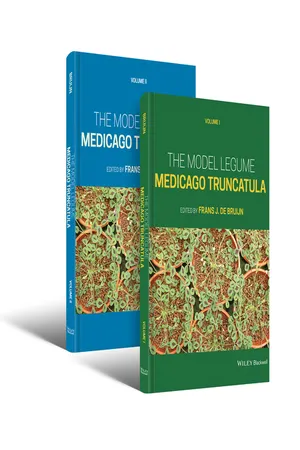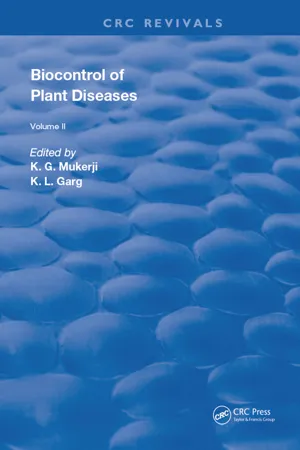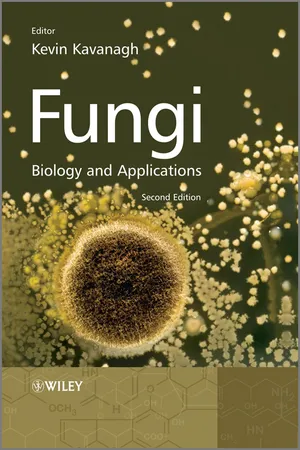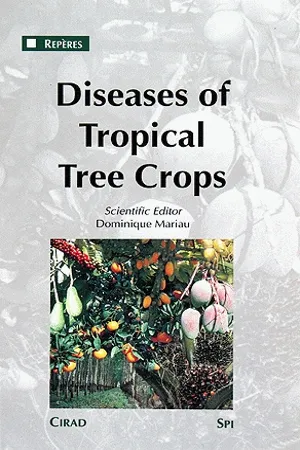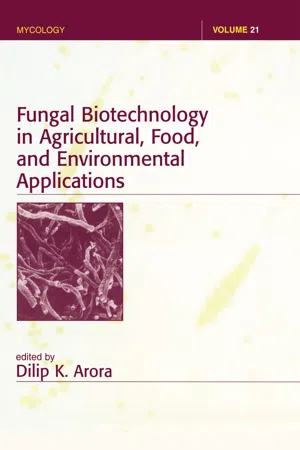Biological Sciences
Rust Fungi
Rust fungi are a group of plant pathogens that cause diseases in a wide range of crops, including wheat, barley, and soybeans. They are characterized by the reddish-brown spores they produce, which give infected plants a rusty appearance. Rust fungi can have significant economic impact by reducing crop yields and quality, making them a focus of agricultural research and management efforts.
Written by Perlego with AI-assistance
8 Key excerpts on "Rust Fungi"
- eBook - ePub
- Frans J. de Bruijn(Author)
- 2019(Publication Date)
- Wiley-Blackwell(Publisher)
U. ciceris-arietini (chickpea rust), U. vignae (cowpea rust), U. trifolii-repentis, U. trifolii, U. minor, and U. anthyllidis (clover rusts), and U. lupinicolus and U. renovatus (lupin rusts). Species from other genera can also be of importance is some legumes, such as Phakopsora pachyrhizi and Ph. meibomiae (soya bean rusts) or Puccinia arachidis (groundnut rust) (Rubiales et al. 2011, 2015). Among these, in the present review, we will focus mainly on U. striatus which is an important disease of worldwide distribution, being particularly damaging in alfalfa grown for seed (Koepper 1942) and which can also damage M. truncatula extensively (Rubiales et al. 2011).Breeding for genetic resistance is the best measure for plant protection against rust, since chemical control can have negative environmental effects and/or high economic costs. The most commonly deployed strategy in rust resistance breeding is the single-gene resistance typically due to a posthaustorial defense mechanism, in which the plant cell collapses after the rust fungus starts to form a haustorium in the cells resulting in hypersensitivity (Niks and Rubiales 2002). Less exploited in breeding are the mechanisms of resistance acting before the formation of haustoria, but which can also contribute to increase the diversity of defenses to Rust Fungi. Indeed, rust infection can be hampered at very early stages of fungal development, from spore deposition to stomata recognition, resulting in a reduced penetration of the fungus into the tissue. This type of prehaustorial resistance is very common in nonhost interactions. However, it can also be a significant component in host interactions, being important in the typically polygenic, so called partial resistance (Parlevliet 1979), or in single gene resistances that proved to be durable. Examples are the Lr34 or Lr46 - eBook - ePub
Fungi Bio-prospects in Sustainable Agriculture, Environment and Nano-technology
Volume 1: Fungal Diversity of Sustainable Agriculture
- Vijay Kumar Sharma, Maulin P. Shah, Shobhika Parmar, Ajay Kumar, Vijay Kumar Sharma, Maulin P. Shah, Shobhika Parmar, Ajay Kumar(Authors)
- 2020(Publication Date)
- Academic Press(Publisher)
Chapter 7Phytopathogenic fungi and their biocontrol applications
Indu Sharma* , Department of Biotechnology, Maharishi Markandeshwar Deemed to be University, Ambala, India *, Corresponding author. Email: [email protected]Abstract
Phytopathology is the scientific study of diseases in plants caused by pathogens (infectious organisms) and environmental conditions (physiological factors). Fungi are among the dominant causal agents of plant diseases. With respect to plant pathogens, fungi represent probably the most diverse group of ecologically and economically important threats. Most phytopathogenic fungi belong to the Ascomycetes and the Basidiomycetes. Phytopathogenic fungi use various strategies to colonize in plants and cause disease. Phytopathogenic fungi possess a wide range of enzymes destroying the carbohydrate polymers, which constitute the building materials of the cell walls. Some fungi kill their hosts and feed on dead material (necrotrophs), while others colonize the living tissue (biotrophs). For successful invasion of plant organs, pathogenic fungi developed strongly regulated and specialized infection structures. To further colonize hosts and establish disease, fungal pathogens organize a plethora of virulence factors and these interactions result in a broad spectrum of outcomes reaching from beneficial interactions to death of the host. Depending on the infection strategy, virulence factors perform different functions. While basically all pathogens interfere with primary plant defense, necrotrophs secrete toxins to kill plant tissue. In contrast, biotrophs utilize effector molecules to suppress plant cell death and manipulate plant metabolism in favor of the pathogen. Biological control of plant diseases with fungal pathogens has been considered a sustainable alternative method comparison to other chemical control. In plant pathology, the term biocontrol applies to the use of microbial antagonists to destroy diseases. Throughout their lifecycle, plants and pathogens interact with a wide variety of organisms. These interactions can expressively affect plant health in several ways. Different mode of actions of biocontrol-active microorganisms in controlling fungal plant diseases include soil amendments, hyperparasitism, entomogenous fungi, predation, antibiosis, cross protection, competition for site and nutrient and induced resistance. Successful application of biological control strategies requires more knowledge-intensive management. Commercial use and application of biological disease control have been slow mostly due to their variable performances under diverse environmental conditions in the field. To overcome this problem and in order to take the biocontrol technology to the field and expand the commercialization of biocontrol, it is important to develop new formulations of biocontrol microorganisms with higher degree of stability and survival. Future outlooks of biocontrol of plant diseases is bright and promising and with the growing demand for biocontrol products among the growers, mass production of biocontrol microorganisms and the use of biotechnology and nano-technology in improvement of biocontrol mechanisms, manage plant diseases, increase yield, protect the environment and biological resources and approach a sustainable agricultural. - eBook - ePub
Fungi
Biology and Applications
- Kevin Kavanagh(Author)
- 2017(Publication Date)
- Wiley-Blackwell(Publisher)
14 Fungal Pathogens of Plants Fiona Doohan and Binbin Zhou 14.1 Introduction A wide range of fungi cause diseases of plants (see Chapter 1 for a description of fungal taxonomy, morphology, and reproduction). To be classified as a fungal plant pathogen or phytopathogen (phyto = plant), a fungus should, if possible, satisfy Koch’s postulates or rules. Koch determined that an organism was the cause of an infectious disease if it can: (1) be isolated from a diseased host, (2) be cultured in the laboratory, (3) cause the same disease upon re‐introduction into another host plant, and (4) be re‐isolated from that host. However, some fungal pathogens cannot be cultured, or in some cases it is not easy to carry out Koch’s tests. Since the early nineteenth century, thousands of fungi have been recognized as parasites of plants. Parasitism occurs where one species lives off another, as distinct from symbiosis where different species live in harmony with each other and the relationship is mutually beneficial, or saprophytism where organisms grow on dead organic matter. Plant‐pathogenic fungi are classified as: Biotrophs : only grow and multiply when in contact with their host plants (and therefore cannot be cultured on nutrient media); for example, the fungi that cause rusts, powdery mildews, and downy mildews. Non‐obligate pathogens : grow and multiply on dead organic matter (and can therefore be cultured on nutrient media) as well as on living host tissue. These can be further distinguished as facultative saprophytes or facultative pathogens. Facultative saprophytes complete most of their lifecycle as parasites, but under certain conditions they grow on dead organic matter - eBook - ePub
- William Bridge Cooke(Author)
- 2019(Publication Date)
- CRC Press(Publisher)
Castanea dentata, the American chestnut.Root rots and root-disease fungi have been studied intensively. Reviews of the various aspects of this work have appeared and need only be mentioned here. The relation of soil fungi to root infection was discussed in an early review.157 Root rots of cereals1036,1037 form one of the more important groups of this general type of disease, but root rots of noncereal crops99 and of deciduous fruit trees275 are also important to these groups of crop plants. Most of the current knowledge of these types of disease-producing fungi has been summarized in recent texts from England.427 ,433Here it is thought that the more primitive types of root-disease fungi are those which invade juvenile or senescent root tissues that have not yet gained or have lost the ability to resist such attack. As the pathogenicity of fungi evolves, it progresses through those root-disease fungi which attack only vascular tissues producing wilts, to those fungi which produce hypertrophy of root tissue without killing the host, and finally to those fungi which live in harmony with their host, causing minimum distortion of host tissues but apparently unable to live without the host plant, as in certain types of mycorrhizae.Specialized studies dealing with various problems of plant pathology, such as the cytology961 ,962and physiology146 ,195of host-parasite relations, and physiologic specialization of parasitic fungi950 ,951have been adequately reviewed. General host-parasite relations have been discussed by Ainsworth.7 Because of their importance in relation to loss of crop by disease incidence, the rusts609 and the smuts195 ,561have been studied intensively in relation to physiologic specialization, hybridization, and genetics. In attempting to control certain diseases by breeding disease resistance into a host, it is also important to learn how rapidly a pathogen can mutate to a disease-producing organism on hosts resistant to earlier strains. Vegetable crops, too, may be subject to breeding for disease resistance.1200 Progress in various types of breeding experiments for disease resistance in wheat, oats, barley, and flax58 and in breeding for resistance to Verticillium and Fusarium wilts1032 - eBook - ePub
- K. G. Mukerji, K.L. Garg(Authors)
- 2020(Publication Date)
- CRC Press(Publisher)
71 The latter approach could be used when a natural control mechanism existed but is shown to be only partly effective. However, it requires a much greater understanding of the mechanisms of action of possible controls and of interactions with other environmental factors. An awareness that biological control works in nature should provide the greatest stimulus to utilize the capacity of the natural microflora to bring about disease control. There are four possible ways by which microorganisms can affect the propagules, infection, and fructification of pathogenic microorganisms, and reduce or control the development of a disease. They are (1) hyperparasitism, (2) antagonism by naturally occurring and foreign microorganisms, (3) immunization or cross protection, and (4) hypovirulence. Now we shall deal with them separately and in detail with examples of various rust and leaf spot diseases.A. Hyperparasitism
Hyperparasitism is the attack of a secondary parasite on a primary parasite. The term hyperparasite refers to the parasitism of one microorganism by another; a mycoparasite is a fungus parasitic on another fungus. Unlike antibiotic producing microorganisms, hyperparasites do not initiate their parasitic activity at a distance, but require an intimate association of the host and parasite. Some hyperparasites obtain nutrients from the living host causing little or no apparent harm; this is “balance” or biotrophic parasitism.13 When the action of the parasite kills the host, the phenomenon is called necrotrophic hyperparasitism. It is the latter mode of action which is of most interest to those concerned with the biological control of plant pathogens. Hyperparasites of fungi were first observed in 1800s by mycologists interested in plant diseases. Most reports of hyperparasites suggest that they might be useful for biological control. The nature of hyperparasitism has been outlined by Barnett13 and the topic reviewed by several authors.24 ,27 ,40 ,43 ,46 ,87 ,100Kuhlman88 has discussed various attributes of hyperparasites providing biological control.1. Rusts
Basidiomycetous fungi, particularly the rusts, have been frequently noted as hosts of other parasites. Since the rusts produce external fructifications as a secondary inoculum helping the disease spread, they are liable to be controlled more effectively by hyperparasites than other disease such as leaf spots. Both primary and secondary inoculum can be parasitized, thereby affecting the disease at the time of infection, and later, the subsequent spread.a. Fungi
One of the earliest reported hyperparasites of rusts is Darluca. It occurs naturally on uredo- and teleutosori of numerous rust species. In early studies of asparagus rust, Smith145 observed the hyperparasite, Darluca filum, growing on uredinia of Puccinia asparagi. Later, the parasitism of Darluca on hemlock rust was studied by Adams2 who found that the mycelium of D. filum ramified throughout the pycnidial and aecial sori of Peridermium peckii - eBook - ePub
Fungi
Biology and Applications
- Kevin Kavanagh(Author)
- 2011(Publication Date)
- Wiley(Publisher)
12 Fungal Pathogens of Plants Fiona Doohan 12.1 Fungal Pathogens of Plants A wide range of fungi cause diseases of plants (see Chapter 1 for a description of fungal taxonomy, morphology and reproduction). To be classified as a fungal plant pathogen or phytopathogen (phyto = plant), a fungus should, if possible, satisfy Koch's postulates or rules. Koch determined that an organism was the cause of an infectious disease if it can: (a) be isolated from a diseased host, (b) be cultured in the laboratory, (c) cause the same disease upon reintroduction into another host plant and (d) be re-isolated from that host. However, some fungal pathogens cannot be cultured or in some cases it is not easy to carry out Koch's tests. Since early in the nineteenth century, thousands of fungi have been recognized as parasites of plants and almost all plants are hosts to particular fungal diseases. Parasitism occurs where one species lives off another, as distinct from symbiosis, where different species live in harmony with each other and the relationship is mutually beneficial, or saprophytism, where organisms grow on dead organic matter. Plant-pathogenic fungi as classified as: Biotrophs: only grow and multiply when in contact with their host plants (and, therefore, cannot be cultured on nutrient media); for example, the fungi that cause rusts, powdery mildews and downy mildews. Non-obligate pathogens: grow and multiply on dead organic matter (and can, therefore, be cultured on nutrient media) as well as on living host tissue. These can be further distinguished as facultative saprophytes or facultative pathogens. Facultative saprophytes complete most of their life cycle as parasites, but under certain conditions they grow on dead organic matter - eBook - ePub
- Dominique Mariau(Author)
- 2001(Publication Date)
- Cirad(Publisher)
Despite the importance accorded to environmental factors and plant materials, we realize increasingly that the pathogen, taking into account its variability, constitutes one of the important elements intervening in host-parasite relationships. This is why researches are focused on the study of the genetic diversity in a good number of fungal parasites. The genetic diversity of the host cannot be dissociated from such studies (the case of orange rust of coffee with its rather numerous races is a very typical example). The use of enzyme markers and molecular biology techniques has helped to refine studies on the structure of pathogenic fungal populations irrespective of the host. This has resulted in a better management of integral control methods using resistant sources, a better comprehension of the development and forecasting of epidemics, increased efficacy of phytosanitary measures and quarantine regulations. These new methods of investigation have opened encouraging prospects towards solving the problems posed by diseases.FUNGI
Numerous are the plant diseases caused by fungi in the tropical world. Temperatures that are often high, together with a quasi-permanent humidity, present optimal conditions for the growth of parasitic fungi, telluric as well as aerial. Most often, the major pathogens responsible for the most serious diseases have spread rapidly thanks to the intensification and expansion of crops, thus giving rise to epidemics. Pronounced and transitory alternations in the climate making the plant highly susceptible to a latent pathogen (for example, Uerticillium dahliae on cocoa and Thielaviopsis paradoxa on coconut) also lead to the development of characteristic disease syndromes.TELLURIC DISEASES
ROTS
The term rot expresses a pathological syndrome characterised by an alteration in the cortical and ligneous tissues of roots leading first to wilting and eventually to the death of the tree. The fungi responsible are the Basidiomycetes, Rigidoporus lignosus (Klotzsch) Imaz. (white rot), Phellinus noxius (Corner) G.H. Cunn. (brown rot), Ganoderma philipii or pseudoferreum (Bres. and P. Henn.) Bres. (red rot), Helicobasidium compactum (Boedijin) Boedijin (purple rot) and Armillaria heimii (crack rot), as well as an Ascomycete, Sphaerostilbe repens Berk. and Broome (collar and root cankers). The importance of the works undertaken by CIRAD in West Africa enabled it to pay special attention to the havoc caused by R. lignosus (Fomes lignosus ) (Kl) Bres., agent of white rot of rubber (Hevea), and A. heimii.Rigidoporus lignosus
Rigidoporus lignosus , a fungal parasite of the roots of a large number of forest and cultivated tree species, belongs to family Polyporaceae of the Class Basidiomycetes. When the forest is felled, the conditions become favourable for the development of Fomes, - Dilip K. Arora(Author)
- 2003(Publication Date)
- CRC Press(Publisher)
Examples of these fungi are Rhizoctonia solani Kühn, various species of Fusarium and Pythium, and Sclerotium rolfsii Sacc. Fungal pathogens that infect the roots and crown of developing plants, causing root and crown rots and vascular wilts, have also been researched for biological control strategies. These include fungi such as Pythium spp., Fusarium spp., and Sclerotinia sclerotiorum (Lib.) de Bary. A third group of foliar-infecting fungi of vegetable crops that cause leaf spots and blights and stem infection, also have biological control strategies developed against them. These include Botrytis cinerea Pers. ex Fr. (gray mold), Didymella bryoniae (Auersw.) Rhem (gummy stem blight), S. sclerotiorum (white mold), and Sphaerotheca and Erysiphe spp. (powdery mildews). Many different fungal and yeast biological control agents have been identified and evaluated for disease control potential against the above-mentioned pathogens, and some have been formulated and brought to market to provide disease control options for producers of vegetable crops. The use of biological control agents may be particularly attractive for vegetable crops grown in glasshouses, due to the high market value of these crops and the possibility for control of environmental parameters, particularly temperature and relative humidity (Paulitz and Bélanger 2001). These are important variables that can significantly influence the efficacy of biological control agents under natural field conditions (Paulitz 1997). The rationale for development of biological control agents against fungal diseases on vegetable crops was to provide an additional/alternative approach to augment/replace the use of chemical fungicides, to provide a level of disease control in the absence of crop genetic resistance, and to augment cultural control practices to further minimize the impact of these diseases and reduce chemical residues in food
Index pages curate the most relevant extracts from our library of academic textbooks. They’ve been created using an in-house natural language model (NLM), each adding context and meaning to key research topics.
Explore more topic indexes
Explore more topic indexes
1 of 6
Explore more topic indexes
1 of 4
